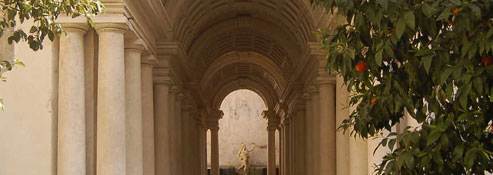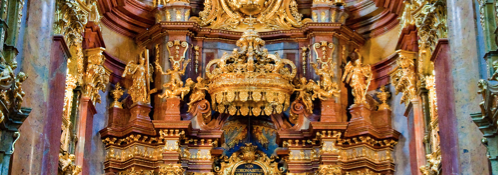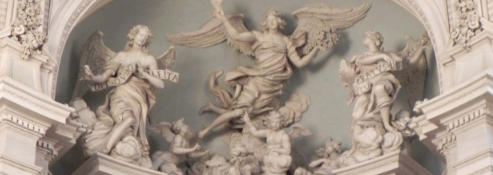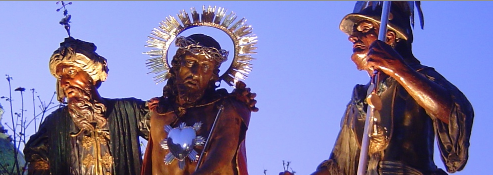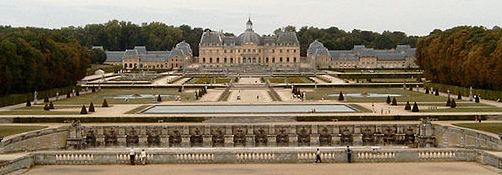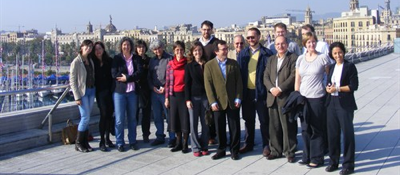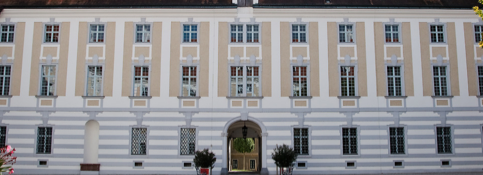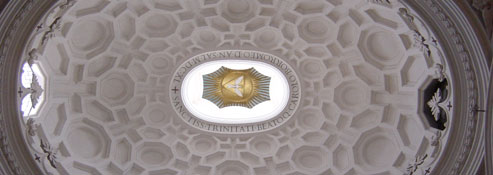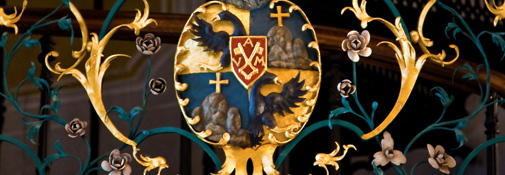Between the end of the sixteenth and first half of the seventeenth centuries, Rome and the rest of Europe witnessed a flourishing of private libraries, a significant increase in what we might define as "State" libraries and to a much lesser extent the creation of libraries for public use. [1] One need only think of the book collections of Fulvio Orsini [2], of cardinal Scipione Lancellotti, of Leone Allaci, scriptor of the Vatican Library, but also of the inauguration in 1604 of the Biblioteca Angelica, founded thanks to a legacy left by the Augustinian Angelo Rocca, the establishment of the Biblioteca Vallicelliana of the Oratoriani, the phase of profound transformation the Vatican Library [3] underwent during the second half of the sixteenth century. [4]
It wasn't just the case of printed texts becoming more accessible and widespread. Libraries responded to a new need for broader scientific, geographical and natural knowledge, which meant that scholars increasingly required appropriate instruments for orientation and comprehension. Moreover, besides the first generalized catalogues and bibliographies, like Konrad Gesner's Bibliotheca universalis published in Zurich in 1545 [5], enormous efforts were made in the sixteenth century to arrange - and dominate - book production within the closely controlled confines of "ideal" libraries, in the attempt to serve up a precise cultural model like the Bibliotheca selecta and Jesuit Antonio Possevino's Apparatus sacer which were printed in 1593 and 1606 respectively and were aimed at good Catholics. [6]
This idea of «disciplinamento intellettuale e religioso» [7] that underlay not only a project like Possevino's but, in general, the great seventeenth century book collections was also clearly present in the mind of French Carmelite Louis-Jacob de Saint-Charles whose Traicté des plus belles bibliothèques publiques et particulières, qui ont esté et qui sont à présent dans le monde was printed in Paris in 1644, together with the second edition of Gabriel Naudé's Advis pour dresser une bibliothèque. Saint-Charles wrote in his dedication to Paul François de Gondy, archbishop of Corinth and coadjutor in the archdiocese of Paris, that a library is an instrument «qui n'est pas seulement utile, mais qui est absolument necessaire à un gran Prelat» who «doit sçavoir par le bons livres, tout ce que lea autres sçavent, et mesme tout ce qu'ils ignorent». [8] In Father Jacob's work extensive space is devoted to Roman libraries and, among these, to the libraries «des cardinaux et des autres». [9] This section also contains a mention of the cavaliere Cassiano del Pozzo (1588-1657) and his «bibliothèque considerable, tant pour ses livres que pour ses antiquitez et histoires naturelles, qu'il recherche avec un gran soin». [10] Dal Pozzo's book collection is also mentioned and celebrated in numerous contemporary texts. [11] In 1686, almost thirty years after Cassiano's death, French historian Jean Mabillon was still able to admire dal Pozzo's entire collection when he visited Italy guided by Cassiano's brother, Carlo Antonio (1606-1689), who continued to look after it. [12]
In spite of this, scholars studying Cassiano dal Pozzo - with a few recent exceptions [13] - have focused more on another sector of his many sided activity: his paper museum (Cassiano coined the expression himself) [14], a vast collection of drawings and prints gathered up in hundreds of albums and arranged into thematic sections. Some 7.000 have been discovered so far, most of which are housed in the British Library and the Royal Library in Windsor Castle. The collection is a kind of museum without any real objects to exhibit, but which was intended to be a systematic and exhaustive representation both of the ancient world (even in its less important productions and expressions) as well as of the natural world, the morphology of its species, the variety of its minerals, its vegetables and animals. It was a grandiose project, in part inspired by Paolo Giovio's sixteenth century idea of a museum understood as a collection of portraits of famous men [15] and to realize it Cassiano availed himself of young, contemporary artists like Pietro Testa and Nicolas Poussin. [16]
The preference of scholars for the paper museum over the library, in my view, fails to take two elements sufficiently into account: the sizeable number of works in the Putean library, which according to one surviving inventory [17], amounted to more than 9.000 titles. It was not only incomparably larger than the best stocked private libraries of the sixteenth century (Erasmus' library counted some 500 titles) [18] but was something of an exception even among seventeenth century Roman libraries. [19] For example, Giulio Mazzarino's library in Rome, later incorporated into the Bibliothèque Mazarine under the care of Gabriel Naudé, numbered some 5.000 titles [20]; the library of cardinal Scipione Lancellotti had slightly more than 7.000. [21] Secondly, the museum and library were clearly designed - the one a library of drawings the other a library of texts - to be spatially associated (both were located on the piano nobile of the dal Pozzo palace [22]) and thus also, mutually accessible, in keeping with a modern rationale of continuous references between iconographic collection and its transposition on the textual level.
Probably this process of scholarly decoupling between museum and library was also favored by the rapid dispersal of all of Cassini's possessions (the collections, the library, the museum, the painting gallery) in the decades following his death in 1657. [23] This vast amount of material, initially in the care of dal Pozzo's brother Carlo Antonio, himself a scholar and bibliophile, was preserved until the beginning of the eighteenth century. In 1703 Dal Pozzo's descendents no longer able to manage the collection, either financially or culturally, proceeded to liquidate it for the enormous sum of 4.500 scudi to the Abbot Zacagni, first custodian of the Vatican Library. Zacagni who was unable to make full payment later sold it in 1714 to cardinal Alessandro Albani, nephew of Clement XI. [24] In 1762 cardinal Albani to help finance construction of the Villa at Porta Salaria decided to sell off many drawings and prints, actually most of the paper museum to representatives of king George III of England, which resulted in the permanent separation of the museum from the library. At the end of the eighteenth century when Napoleon's troops occupied Rome, the Albani princes' possessions were confiscated and looted. Some of them ended up in France (where today a small portion can be found in Montpellier), another part was sold off haphazardly and after a century was painstakingly and only partly recovered by the librarians of the refounded Accademia dei Lincei. [25]
The collection's troubled and complex history today makes the study of such rich and fragmentary material a very challenging task. For this reason it is worth taking a closer look at the initial planning and creation stages of Cassiano dal Pozzo's library.
On August 12, 1623, six days after Urban VIII ascended to the pontifical throne, the scientist Francesco Stelluti wrote to Galileo Galilei from Rome: «La creazione del nuovo pontefice ci ha tutti rallegrati, essendo di quel valore e bontà che V.S. sa benissimo, et fautore particolarmente de' letterati, onde siamo per havere un mecenate supremo». [26] Stelluti went on to inform Galilei about the honorary offices recently bestowed on fellow members of the Accademia dei Lincei. [27] One of these, Cassiano dal Pozzo, associate of the Lincei in 1622 in the class of philosophy and natural history, was engaged in the service of cardinal Francesco Barberini. [28] At this time dal Pozzo was still residing in via della Croce where he had lived since first coming to Rome from Tuscany. [29] Just a few years later, in 1627, a confident in the Barberini entourage, dal Pozzo moved closer to the Barberini, who were then still living in via dei Giubbonari [30], in the palace owned by the Theatine fathers of S. Andrea della Valle, situated in via dei Chiavari and destined to become the "container" of the Putean collections including the library. [31]
As Amadeo Quondam has written, the libraries' inventories «propongono in realtà più problemi che informazioni». [32] Interpreting such sources - book catalogues - is always a complex undertaking. Lists were often drawn up as part of bureaucratic procedures that accompanied sales or inheritances.
Two of the three extent inventories of the dal Pozzo library are certainly linked to two notarial deeds and, hence, they are easily dateable: the first was redacted between March and June 1714 and concerns the sale of the library to cardinal Albani. It exists in two copies in the Vatican Library. [33] The library's texts are divided into topics (Medical, Chemical, Surgical, etc.). This is the most recent of the known inventories, but also the one with the smallest number of titles. The second is found in the "Archivio di Stato di Roma" and is part of the inventory of Cassiano's possessions that was drawn up immediately after the death of his brother Carlo Antonio on August 1, 1689. [34] Bibliographically, the catalogue is rather spare. It lists only the names of authors and very often the titles are missing, nearly always the place and date of publication. The texts are classified into thematic areas (legal books, grammar, mathematics, natural history), format (folio, quarto, ottavo, etc.). Looking over the list, one gets the impression that the main purpose of compiling it was to give an idea of the library's great number of items rather than its quality. There are some 5,000 titles, considerably more than in the eighteenth century inventory (where entire sections are missing: ex. Militares, Munitiones, Tormenta bellica; all the biographies) but far fewer than the inventory I worked on, which as I have mentioned, numbered more than 9.000 items. The third inventory, which is preserved in the Biblioteca Corsiniana is unquestionably the richest, also bibliographically speaking. [35] Not only does it indicate the work's author, title, city or date of publication and often the printer, but also the language it was written in (many works in French or Spanish) and whether or not it was illustrated. The manuscript is not dated, however, it lists various volumes that were published in the 1680s and some in the 1690s including, for example, the Vetera Monumenta by the scholar Giovanni Giustino Ciampini. [36] The inventory, therefore, must be later than that date. The accuracy of the inventory's bibliographic information suggests that its purpose was to facilitate access and use of the library. Moreover, the analysis of the sections devoted to books on history, which we have examined here leads to the hypothesis that this is a topographic inventory. [37] In fact, within the single sections, the works appear to be grouped according to subject matter (for example, the history of France or of Spain, of Flanders or of Portugal, of Piemonte, or Florence or of the Kingdom of Naples) suggesting that the works may have been physically located near each other on the library's bookshelves.
In order to get an accurate picture of the characteristics of dal Pozzo's library we need to determine exactly what volumes Cassiano himself acquired over time, since his collection had absorbed not only the libraries of his father and uncle Carlo Antonio. [38], but a large part of Federico Cesi's library, which Cassiano had acquired in 1633 for 758 scudi, thanks to the intercession of fellow member of the Accademia dei Lincei, Francesco Stelluti, who was seeking to prevent the library of the Academy's founder from being dismembered. [39] As regards the printed works, we can be surer about the works that bear a date after Cesi's death in 1630. It would also be useful to carefully crosscheck dal Pozzo's extensive correspondence with persons in various parts of Europe. Many of the letters deal with his search for works and their availability on the book market, the acquisition or copying of texts that were destined for his library. [40] It should also be remembered that some, though not a sizeable portion, of the texts in the inventory have a publication date subsequent to Cassiano's death (1657) and were obviously added to the library by his brother Carlo Antonio who continued to look after and preserve the collection. Among these we have, for example, are the Diatriba de adventu S. Jacobi in Hispania by the Portuguese Jesuit Francisco Macedo from 1662, Il trionfo di Carlo VIII by Donato Donati, printed in Ronciglione (Viterbo) in 1662, the Biblioteca Napoletana by Niccolò Toppi from 1678, Baltasar Gracián's Criticón printed in Italian translation in Venice in 1685 and, finally, the funeral oration for Cassiano, composed by his friend Carlo Dati and published in Florence in 1664. [41]
In the Corsiniana inventory the history books are not included in a single section (as for example, in the Vatican inventory which contains single section of texts designated "Historici"), but they are classified by every format (folio, quarto, ottavo, dodicesimo) into the four main categories: Historia sacra, Historia Antiqua, Historia Nova and finally Cronici et Cronologici. In the folio format there appears an additional section entitled Geografici, Cronologici et Historici which lists 264 titles which are mostly histories of Asia, China, the Indies and accounts of voyages to the Orient. The fact that there are these specific sections does not mean that various historical texts may not be found in other sections as well. For example the Libri ecclesiastici also include the Opera omnia by Lorenzo Valla printed in Basel in 1543, among the Genealogici de familijs there is the Storia della Casa Orsini by Francesco Sansovino or Suetonius' Lives of the Twelve Caesars, and this does not consider examples of leakage or overlapping from one field to another, between history and politics, history and law, history and ethics. Historical works catalogued in the sections Geografici, Cronologici et Historici, in folio, cc. 17v-22v; Historia sacra, in quarto, cc. 44v-45r; Historia antiqua, in quarto, cc. 45v-48r; Historia nova, in quarto, cc. 48r-50v; Cronici et Cronologici, in quarto, cc. 52v-53r; Historia sacra, in ottavo, c. 113r-v; Historia antica, in ottavo, cc. 113v-115v; Historia nova, in ottavo, cc. 115v-117v; Cronologici, in ottavo, cc. 118r-124r; Historia sacra, in dodicesimo, c. 145r-v; Historia antiqua, in dodicesimo, cc. 145v-146r; Historia nova, in dodicesimo, cc. 146r-148r; including a section of 122 titles designated as Memorabili (cc. 50v-52v), which contains many humanist tales and a section of 43 titles Ad historiam facientes (c. 53r-v) containing mostly reports, speeches, letters, all told about 1.500 items. Only a small portion of these, less than one fifth, are editions of classical Latin and Greek authors.
Thanks to these purely numeric data we can make a few preliminary remarks. Of particular note is the interest for works of history, which make up the largest share of items, both among the humanistic disciplines and the library as a whole. A glance at the inventory shows the absolute predominance of "historiae novae" over classic texts and great attention to the evolving cultural and historical debates and their latest developments, as may be seen for example by the presence in the inventory of works such as Dialogo dell'historia (Venice 1560) by Francesco Patrizi, the Discorsi istorici (Venice 1569) by Cosimo Bartoli, but also Agostino Mascardi's Arte historica (Rome 1636) and Paolo Pirani's Dodici capi pertinenti all'arte historica del Mascardi (Venice 1646). [42]
As for late sixteenth century and humanist historiography the impression one gets from looking over the inventory is one of exhaustiveness, since it contains most of the contemporary historical works, assembled according to a pre-encyclopaedic logic: from Matteo Villani's chronicles and the historical works of Poggio Bracciolini, Leonardo Bruni, Iacopo Nardi, Bernardino Corio, Giovanni Pontano, Paolo Giovio, Francesco Guicciardini, Camillo Porzio, Scipione Ammirato, to histories of France (Omero Tortora, Enrico Catarino Davila, Antonio Pigafetta), of Flanders, of England, of Poland, of the Turks and Pier Francesco Giambullari's history of Europe. A number of works are represented in more than one edition, such as Guicciardini's Storia d'Italia. Cassiano mentions the work in a 1630 letter to a fellow collector advising him to find the two volume edition published in Florence by Lorenzo Torrentino and buy it at whatever the price. The purchase was made since the dal Pozzo inventory lists both Florentine editions of 1561 (both the folio and ottavo). [43] I was unable to find historical works by another great sixteenth century Florentine thinker and historian, Niccolò Macchiavelli in the sections of the inventory I examined, though there is no absence of famous texts refuting Macchiavelli, like Tomasso Bozio's Adversus Machiavellum (Rome 1596). [44] and Le Prince by Jean Louis Guez de Balzac (Paris 1634). [45] But the list of historical works also includes texts like Historia della Città e Regno di Napoli (Naples 1602) by Giovanni Antonio Summonte, who was imprisoned and forced to write some portions of his history according to the instructions of the revisers; the edition of the Historia del Concilio Tridentino by Paolo Sarpi, printed in London in 1619 under the false name of Pietro Soave Polano; the Diálogo de las cosas occurridas en Roma by Alfonso de Valdés whose name was prudently omitted and whose title is given in Italian with an indication that the text was in Spanish; the Satyre Ménipée condemned by the Index in a decree of March 16, 1621. [46] We are not able to determine how these texts made their way into dal Pozzo's library, however, Stelluti who oversaw the sale of Federico Cesi's library to Cassiano after the death of the founder of the Academy, informs us that the collection contained a section of prohibited books that required permission to be sold along with the rest of Cesi's library. [47]
The sections of the inventory devoted to historical works are remarkable for their extraordinary quantity of historical and geographical writings about the Orient and we get the impression that the list contains every item the European book market was able to offer on this topic during those years. Indeed, Cassiano's interest in the Orient is also mentioned in Carlo Dati's funeral oration for him, and among the numerous donations from the dal Pozzo library to the Biblioteca Mazarine he refers to the «Libri Indiani e Chinesi, per novero molti, e per qualità singolari». [48] As is well known, the curator and principal organizer of the Mazarine library was Gabriel Naudé, who lived in Rome in the 1630s. Naudé was also librarian of the Barberini brothers, nephews of pope Urban VIII, and great friend of Cassiano as may be seen in the many letters he exchanged over a twenty years period beginning in 1634. The 98 letters are one of the richest sections of dal Pozzo's correspondence. [49] In his Advis pour dresser une bibliothèque Naudé described a model for a universal library, organized into thematic sections that were intended to exclude nothing, ancient authors and especially the great moderns, and whose ideal user would be «cosmopolita o abitante del mondo intero, che può saper tutto, veder tutto e nulla ignorare». [50] Naudé left Italy in 1641 and the euphoria, which had welcomed the beginning of the Barberini pontificate had long since subsided. Among the honourable Academicians of the Lincei, only Stelluti and Cassiano were allowed to remain in the city, but in a radically altered historical and cultural context. [51]
Notes
1. M. Rosa, I depositi del sapere: biblioteche, accademie, archivi, in P. Rossi (ed.), La memoria del sapere. Forme di conservazione e strutture organizzative dall'antichità a oggi, Rome-Bari 1988, pp. 165-209; E. Irace - M.A. Panzanelli Fratoni, Le biblioteche nell'Italia moderna, in S. Luzzatto - G. Pedullà (eds.), Atlante della letteratura italiana, vol. II, E. Irace (ed.), Dalla Controriforma alla Restaurazione, Turin 2011, pp. 415-420. On the historiographical controversy with regard to private libraries in Europe and Italy, I refer the reader to F. Dallasta, Eredità di carta. Biblioteche private e circolazione libraria nella Parma farnesiana (1545-1731), Milan 2010, pp. 19-62; L. Ceriotti, Scheletri di biblioteche, fisionomie di lettori. Gli 'inventari di biblioteca' come materiali per una anatomia ricostruttiva della cultura libraria di antico regime, in E. Barbieri e D. Zardin (eds.), Libri, biblioteche e cultura nell'Italia del Cinque e Seicento, Milan 2002, pp. 373-432. On the prevalence of libraries in Italy during the Renaissance, see essays by Ch.S. Celenza - B. Pupillo, Le grandi biblioteche pubbliche nel Quattrocento, in Atlante della letteratura italiana cit., vol. I, A. De Vincentiis (ed.), Dalle origini al Rinascimento, Turin 2010, pp. 313-321.
2. Still valid is P. de Nolhac, La bibliothèque de Fulvio Orsini. Contributions à l'histoire des collections d'Italie et à l'étude de la Renaissance, Paris 1887. On Orsini, librarian of cardinal Ranuccio Farnese in Roma, see F. Matteini, Orsini, Fulvio, in Dizionario Biografico degli Italiani, Rome 2013, vol. LXXIX, ad vocem.
3. D. Musti, Allacci, Leone, in Dizionario Biografico degli Italiani cit., vol. II, 1960, ad vocem.
4. Storia della Biblioteca Apostolica Vaticana, vol. II, M. Ceresa (ed.), La Biblioteca Vaticana tra riforma cattolica, crescita delle collezioni e nuovo edificio (1535-1590), Vatican City 2012, and vol. III soon to be published.
5. L. Balsamo, Il canone bibliografico di Konrad Gesner e il concetto di biblioteca pubblica nel Cinquecento, in G. De Gregori e M. Valenti (eds.), Studi di biblioteconomia e storia del libro in onore di Francesco Barbéri, Rome 1976, pp. 77-95; A. Moreni, 'La "Bibliotheca universalis" di Konrad Gesner e gli Indici dei libri proibiti', in La Bibliofilia, LXXXVIII (1986), pp. 131-150.
6. L. Balsano, Antonio Possevino S.I. bibliografo della Controriforma e diffusione della sua opera in area anglicana, Florence 2006.
7. M. Rosa, I depositi del sapere cit., p. 181.
8. L.-J. de Saint-Charles, Traicté des plus belles bibliothèques publiques et particulières, qui ont esté et qui sont à présent dans le monde, Paris, chez Rolet le Duc, 1644, c. a iijv.
9. Ivi, p. 93.
10. Ivi, p. 110.
11. G. Lumbroso, Notizie sulla vita di Cassiano dal Pozzo, protettore delle belle arti, fautore della scienza dell'antichità nel secolo XVII: con alcuni suoi ricordi e una centuria di lettere, Turin 1875, p. 30.
12. J. Mabillon, Iter italicum litterarium annis MDCLXXXV et MDCLXXXVI, Paris 1687, p. 143 (this text can be found in dal Pozzo's library, Biblioteca Corsiniana, Archivio dal Pozzo, ms. 40, c. 83v: «Mabylon Iter Italicum Parisis 1687»). See also G. Tiraboschi, Storia della letteratura italiana, Firenze 1812, t. VIII, p. I, p. 73. On Mabillon and Italy see F. Russo, "Medieval art studies in the Republic of Letters: Mabillon and Montfaucon's Italian connections between travel and learned collaborations", in Journal of Art Historiography, VII (2012), pp. 1-24. On Carlo Antonio dal Pozzo see I. Herklotz, Cassiano Dal Pozzo und die Archäologie des 17. Jahrhunderts, München 1999, pp. 101-118; D.L. Sparti, Le collezioni dal Pozzo. Storia di una famiglia e del suo museo nella Roma seicentesca, Modena 1992, pp. 51-63; F. Solinas, dal Pozzo, Carlo Antonio, in Dizionario Biografico degli Italiani cit., vol. XXXII, 1986, ad vocem.
13. S. De Renzi, Contributo per una ricostruzione della biblioteca privata di Cassiano dal Pozzo, in E. Canone (ed.), Bibliothecae selectae da Cusano a Leopardi, Florence 1993, pp. 139-170; D.L. Sparti, Le collezioni dal Pozzo cit., pp. 113-125; Ead., "The dal Pozzo collection again: the inventories of 1689 and 1695 and the family archive", in The Burlington Magazine, 132 (1990), pp. 551-570; F. Solinas, Percorsi puteani: note naturalistiche ed inediti appunti antiquary, in F. Solinas (ed.), Cassiano dal Pozzo, Atti del Seminario Internazionale di Studi, Rome 1989, pp. 95-129; A. Alessandrini, Cimeli lincei a Montpellier, Rome 1978, pp. 17-47.
14. G. Lumbroso, Notizie sulla vita di Cassiano dal Pozzo cit., p. 38. There is a vast bibliography on the paper museum and Cassiano dal Pozzo's activity as a naturalist and collector including an edition of studies Quaderni puteani, edited by Olivetti (4 volumes from 1989 to 1993). Here I refer the reader only to F. Haskell-S. Rinehart, "The Dal Pozzo Collection. Some new Evidence", in The Burlington Magazine, CII (1960), pp. 318-326; F. Solinas (ed.), Cassiano dal Pozzo cit.; D.L. Sparti, "Le collezioni dal Pozzo" cit., pp. 65-112 e p. 127 ff.
15. F. Minonzio, Gli "Elogi degli uomini illustri": il "Museo di carta" di Paolo Giovio, in P. Giovio, Elogi degli uomini illustri, Turin 2006, pp. XVII-LXXXVII.
16. F. Solinas - A. Nicolò, Cassiano dal Pozzo and Pietro Testa. New Documents Concerning the Museo Cartaceo, in E. Cropper (ed.), Pietro Testa, 1612-1650. Prints and Drawings, Philadelphia 1988, pp. LXVI-LXXXVI; H. McBurney, Poussin et le "Museo cartaceo" de Cassiano dal Pozzo, in Catalogue of the exhibition Nicolas Poussin 1594-1665, edited by P. Rosenberg and L.-A. Prat, Paris 1994, pp. 48-57.
17. Biblioteca Corsiniana, Archivio dal Pozzo, ms. 40, c. 159r-v.
18. P. Armandi, Erasmo da Rotterdam e i libri. Storia di una biblioteca, in E. Canone (ed.), Bibliothecae selectae cit., pp. 13-72; but also see L. Bocca- J.-L. Fournel, La biblioteca di Baldassar Castiglione, in Atlante della letteratura italiana cit., vol. II, p. 14-18; M. Danzi, La biblioteca del cardinal Pietro Bembo, Genève 2005.
[19] For some examples of the size of libraries see E. Canone, Le biblioteche private di eruditi, filosofi e scienziati dell'età moderna, in Id. (ed.), Bibliothecae selectae cit., pp. IX-XXXII.
20. L. Bianchi, Per una biblioteca libertina: Gabriel Naudé et Charles Sorel, ibid., pp. 171-215.
21. L.-J. de Saint-Charles, Traicté des plus belles bibliothèques publiques et particulières, qui ont esté et qui sont à présent dans le monde, Paris, chez Rolet le Duc, 1644, p. 97. On Scipione Lancellotti see P. Cavazzini, Palazzo Lancellotti ai Coronari, Rome 1998.
22. D.L. Sparti, Criteri museografici nella collezione dal Pozzo alla luce di documentazione inedita, in F. Solinas (ed.), Cassiano dal Pozzo cit., pp. 221-240.
23. E. Stumpo, Dal Pozzo, Cassiano junior, in Dizionario Biografico degli Italiani cit., vol. XXXII, 1986, ad vocem; D.L. Sparti, Le collezioni dal Pozzo cit., pp. 25-49. For the story of the library after Cassiano's death, see A. Alessandrini, Cimeli lincei cit., pp. 17-27.
24. A. Alessandrini, Cimeli lincei cit., p. 20.
25. A. Nicolò, Il carteggio puteano: ricerche e aggiornamenti, in F. Solinas (ed.), Cassiano dal Pozzo cit., pp. 15-24: 19; Ead., Il carteggio di Cassiano dal Pozzo, Firenze 1991.
26. Cit. in M. Spagnolo, I luoghi della cultura nella Roma di Urbano VIII, in Atlante della letteratura italiana cit., vol. II, p. 387.
27. On Stelluti, see the miscellaneous volume A. Alessandrini, R. Armezzani, B. Beltrame, T. Gazzini, E. Mezzanotte, A. Nicolò, I. Quagliarini (eds.), Francesco Stelluti Linceo da Fabriano, Fabriano 1986.
[28] Cassiano dal Pozzo, Il diario del viaggio in Spagna del cardinale Francesco Barberini, edited by A. Anselmi, Madrid 2004.
29. D.L. Sparti, Le collezioni dal Pozzo cit., pp. 95-99.
30. Ivi, p. 95.
31. D.L. Sparti, Criteri museografici cit., p. 222.
32. A. Quondam, Le biblioteche della corte estense, in Id. (ed.), Il libro a corte, Atti del seminario di studi (Ferrara, 2-5 novembre 1989), Rome 1994, pp. 7-38: 34-35. On this topic see also E. Barbieri, Dal torchio al pluteo. L'ingresso degli incunaboli nelle raccolte librarie italiane del XV secolo, in Id., Il libro nella storia. Tre percorsi, Milan 1999, pp. 117-202; L. Ceriotti, Scheletri di biblioteche, fisionomie di lettori cit.
33. Biblioteca Apostolica Vaticana, Vat. Lat. 10478-10481. Cf. A. Alessandrini, Cimeli lincei cit., p. 21 and D.L. Sparti, Le collezioni dal Pozzo cit., p. 124, note 60.
34. Arichivio di Stato di Roma (ASR), Notai Capitolini, ufficio 25, vol. 419, 12 settembre 1689.
35. Bilioteca Corsiniana, Archivio dal Pozzo, ms. 40.
36. Biblioteca Corsiniana, Archivio dal Pozzo, ms. 40, c. 26v.
37. S. De Renzi, Contributo per una ricostruzione della biblioteca privata di Cassiano dal Pozzo cit., p. 145.
[38] E. Stumpo, Dal Pozzo, Carlo Antonio, in Dizionario Biografico degli Italiani cit., vol. XXXII, 1986, ad vocem.
39. M.T. Biagetti, La biblioteca di Federico Cesi, Roma 2008, pp. 40-42; Ead., La biblioteca di Federico Cesi. Un progetto di ricostruzione, in A. Nuovo (ed. by), Biblioteche private in età moderna e contemporanea, Proceeding of the International Conference (Udine, October 18-20, 2004), Milan 2005, pp. 95-103; A. Capecchi, "Per la ricostruzione di una biblioteca seicentesca: i libri di storia naturale di Federico Cesi Lynceorum Princeps", in Atti della Accademia Nazionale dei Lincei. Rendiconti della Classe di Scienze Morali, Storiche e Filologiche, s. VIII, XLI (1986), pp. 145-164: p. 148. For the relationship between Stelluti and Cassiano see A. Nicolò, "Corrispondenza inedita di Francesco Stelluti", in Atti della Accademia Nazionale dei Lincei. Rendiconti della Classe di Scienze Morali, Storiche e Filologiche, s. VIII, XXXVII (1982), pp. 92-99.
40. A. Nicolò, Il carteggio di Cassiano dal Pozzo cit.
41. The references are found in the Biblioteca Corsiniana, Archivio dal Pozzo, ms. 40, cc. 44v, 48v, 1v, 82r, 59r.
42. Biblioteca Corsiniana, Archivio dal Pozzo, ms. 40, c. 52v.
43. Letter by Cassiano dal Pozzo to Agnolo Galli, February 16, 1630: «Riceverei gratia che V.S. facesse cercare a' Librari se si potesse trovare la Storia del Guicciardino in due tomi di stampa del Torrentino in 8°, che mentre sia ben conditionata non guarderei a prezzo», cit. in D.L. Sparti, Le collezioni dal Pozzo cit., p. 122. Biblioteca Corsiniana, Archivio dal Pozzo, ms. 40, cc. 21v e 116r.
44. Biblioteca Corsiniana, Archivio dal Pozzo, ms. 40, c. 53r.
45. Ivi, c. 121r.
46. Elenchus librorum omnium tum in Tridentino, Clementinoque Indice, tum in alijs omnibus sacrae Indicis Congreg.nis particularibus Decretis usque ad annum 1640 prohibitorum, per Fr. Franciscum Magdalenum Capiferreum ordinis Praedicatorum dictae Congreg.nis Secretarium digestus, editio secunda aucta, Romae, ex Typographia Rev. Cam. Apost., 1640, pp. 232 and 355.
47. M.T. Biagetti, La biblioteca di Federico Cesi cit., pp. 100-101.
48. Ivi, p. 123.
49. G. Ferretti, Il volume delle lettere di Gabriel Naudé a Cassiano dal Pozzo, in F. Solinas (ed.), Cassiano dal Pozzo cit., pp. 25-30.
50. M. Rosa, I depositi del sapere cit., p. 191. See also L. Bianchi, Per una biblioteca libertina cit.
51. I. Fosi, All'ombra dei Barberini. Fedeltà e servizio nella Roma barocca, Rome 1997; P. Rietbergen, Power and religion in Baroque Rome. Barberini cultural Policies, Leiden-Boston 2006; L. Mochi Onori, S. Schütze, F. Solinas, I Barberini e la cultura europea del Seicento, Proceedings of the International Conference (Palazzo Barberini alle Quattro Fontane, December 7-11, 2004), Rome 2007.



